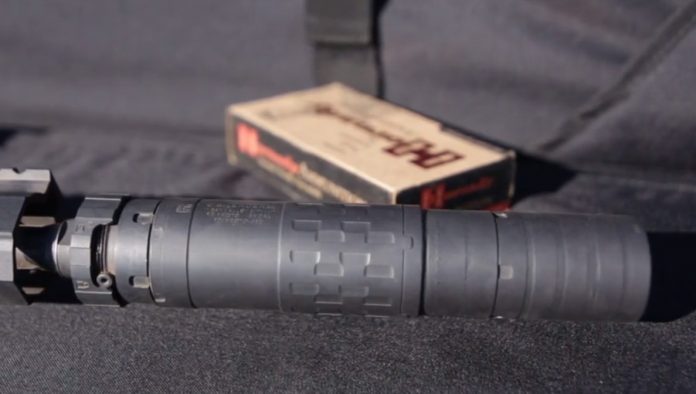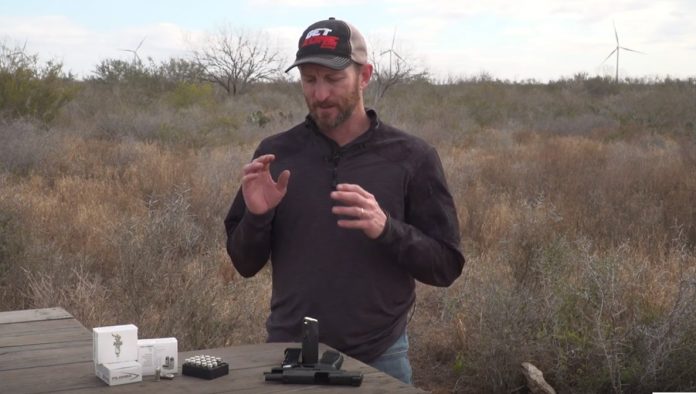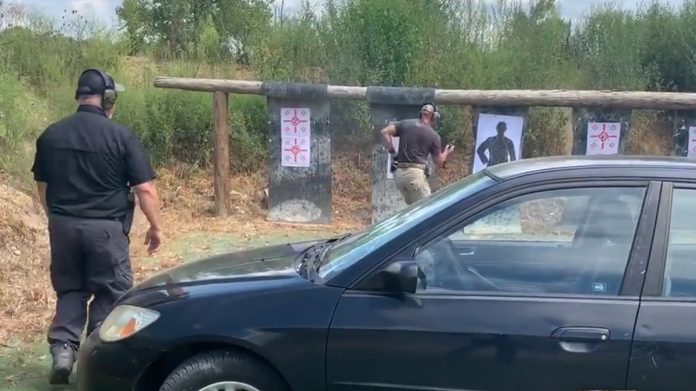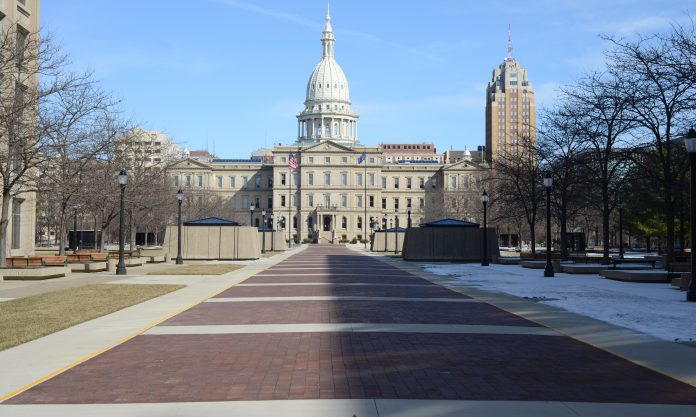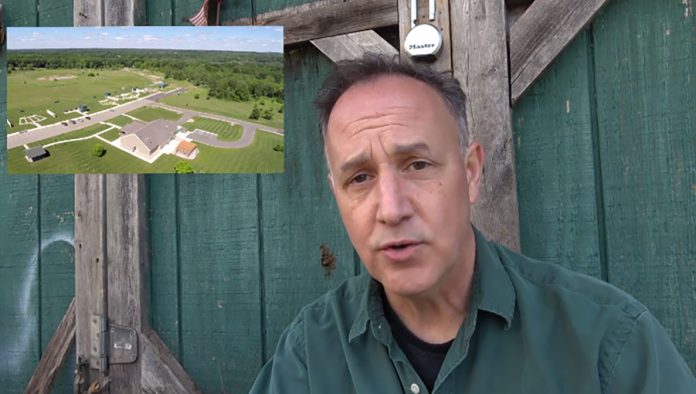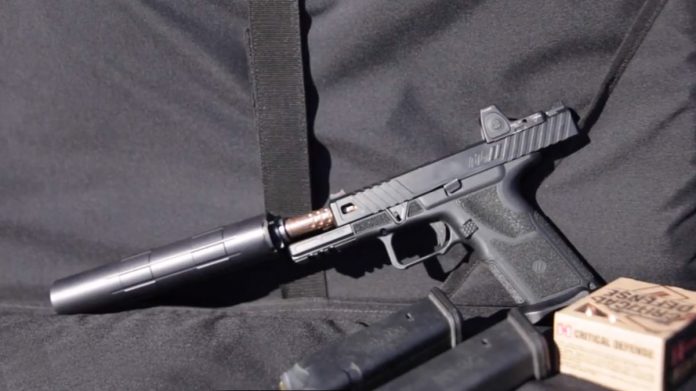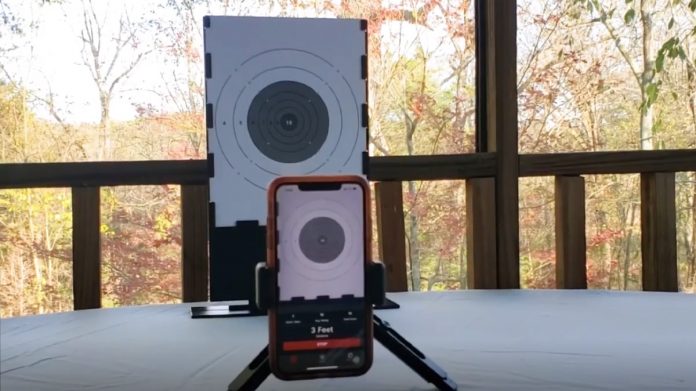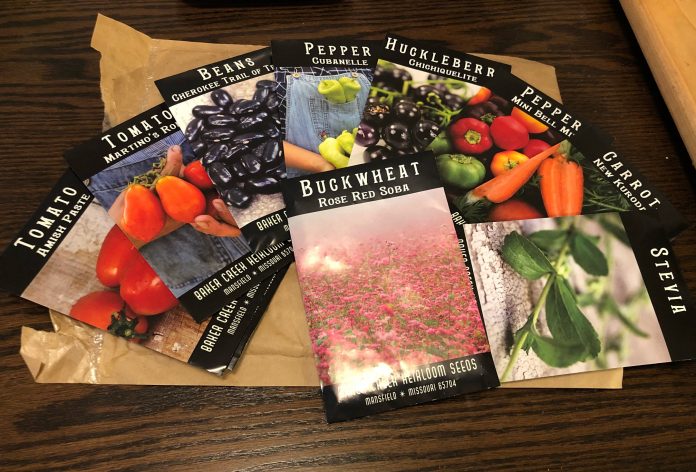SIG SAUER Completes Final Delivery of Next Generation Squad Weapon System to U.S. Army
NEWINGTON, N.H., (February 2, 2021) – SIG SAUER, Inc. is proud to announce the final delivery of the Next Generation Squad Weapons (NGSW) systems to the U.S. Army, consisting of the revolutionary 6.8×51 hybrid ammunition, the NGSW-AR lightweight belt-fed machine gun, the NGSW-R rifle, and suppressors.

“This historic moment is the culmination of an incredible collaboration between the U.S. Army and SIG. We commend Army leadership for having the vision to undertake this monumental procurement process and for remaining vigilant in their mission to bring a modern, transformational weapon system to the battlefield,” began Ron Cohen, President and CEO of SIG SAUER. “Throughout the program we have been given unprecedented access to the soldiers and Marines who will ultimately field these weapons. These soldier touchpoint events have led to rapid advancements over the current weapons systems and resulted in our delivery of the most innovative Next Generation Squad Weapons system to the U.S. Army.”

Each component of the SIG SAUER NGSW system offers significant advancements in battlefield weapons performance beginning with the SIG SAUER 6.8×51 Hybrid Ammunition – a lightweight cartridge designed to handle higher pressures resulting in increased velocity and terminal performance. The SIG SAUER Lightweight Belt-Fed Machine Gun (NGSW-AR) doubles the effective range and is 40% lighter than the current M249 while maintaining the preferred belt-fed operation, with reduced felt recoil to increased accuracy. The SIG SAUER Rifle (NGSW-R) is built on the foundation of the battle tested MCX platform with the added firepower of the 6.8×51 round; both the NGSW-AR and NGSW-R feature familiar AR-style ambidextrous ergonomics designed for a seamless transition from the legacy weapons to the SIG NGSW system. The final component of the system is the SIG SAUER Next Generation Suppressors for reduced sound signature.

We are immensely proud that our entire NGSW submission has been designed, engineered, and manufactured as one integrated system by one single American company at our U.S. facilities,” continued Cohen. “Each component has been exhaustively tested with the others to ensure peak operational performance and endurance for the rigors of the battlefield.”

“As a leader in the firearms manufacturing industry we understand the challenge of bringing a system like this to reality. We designed our NGSW system to be production ready and with every component coming from SIG, it presents minimal fielding risk to the U.S. Army. The form, fit, and function of the firearms is familiar to our warfighters so the transition in the training and qualification of soldiers and Marines is faster and easier, and despite its revolutionary design, hybrid ammunition can be manufactured on a widespread basis immediately. We have a proven and successful track record of delivering multi-branch, service-wide, successful weapons programs to the U.S. Army, and we stand ready,” concluded Cohen.

The revolutionary designs and engineering advancements that were made throughout the development of the SIG NGSW system have ushered the launch of multiple commercially available products in the coming months. These products include SIG FURY hybrid ammunition which uses the NGSW cartridge design for various calibers, and recently gained the regulatory Small Arms and Ammunition Manufacturers Institute (SAAMI) approval, the MCX-SPEAR semi-automatic rifle, and the SIG Next Generation Suppressors.
Visit sigsauer.com to learn more about the U.S. Army selection and delivery of the SIG SAUER Next Squad Weapons .
About SIG SAUER, Inc.
SIG SAUER, Inc. is a leading provider and manufacturer of firearms, electro-optics, ammunition, airguns, suppressors, and training. For over 250 years SIG SAUER, Inc. has evolved, and thrived, by blending American ingenuity, German engineering, and Swiss precision. Today, SIG SAUER is synonymous with industry-leading quality and innovation which has made it the brand of choice amongst the U.S. Military, the global defense community, law enforcement, competitive shooters, hunters, and responsible citizens. Additionally, SIG SAUER is the premier provider of elite firearms instruction and tactical training at the SIG SAUER Academy. Headquartered in Newington, New Hampshire, SIG SAUER has over 2,300 employees across nine locations. For more information about the company and product line visit: sigsauer.com.
The New Zealand Royal Commission Undermines NZ’s New Gun Laws
[Ed: Our esteemed Northern colleague, distinguished researcher Gary Mauser, PhD, graciously offered for DRGO to publish his newest work. We believe the American government would also do well to learn from New Zealand’s experience.]
In their December report about the 2019 terrorist attack in Christchurch, the findings of the New Zealand Royal Commission critically undermined the justifications for the new Draconian firearms laws. Following the attack, Prime Minister Ardern promised, “Our gun laws will change,” going on to impose a wide range of new firearms restrictions. Ardern exploited public horror to expand government powers following the plans she and the police had started before the terrorist attack.
Never let a crisis go to waste
Immediately after the terrorist attacks in Christchurch in March 2019, Ardern responded by launching a “buyback” of scary-looking guns (i.e., “military-style semi-automatic” firearms) through an order in council. She did so, without waiting for the report from the Royal Commission of Inquiry she had set up “to investigate whether Public sector agencies had done all they could to protect the people of New Zealand from terrorist attacks and whether more could be done.” Ardern’s decision to focus on firearms was blatantly self-serving and was done despite official recognition that there was no evidence that banning semi-automatic firearms would have any effect on violent crime or gun deaths.
Ardern followed up the buyback with a flurry of new gun restrictions. Two “tranches” of firearms restrictions were hustled through Parliament, first in 2019, and then another in early 2020. The first tranche, The Arms (Prohibited Firearms, Magazines and parts) Amendment Bill, banned a large number of semi-automatic and military-style weapons, such as those used during the Christchurch terrorist attack. The second tranche imposed a universal firearms registry among other radical changes. The new restrictions include reducing the 10-year firearms licence to five years; barring visitors to New Zealand from purchasing firearms; increasing the powers of police to take guns; requiring a firearm licence for purchasing ammunition and parts, and registering the country’s estimated 260 gun clubs. Applicants will now be required to include the name of a “health practitioner” as a reference who the police can consult before issuing a licence.
Police negligence
Ardern claimed that new laws were needed because the killer got his guns legally. The facts say otherwise. The Royal Commission found that police negligence allowed the terrorist, a racist environmentalist, to get his firearms licence. The Commission documented how Police mismanagement was responsible, “the guidance given by the New Zealand Police to licensing staff was inadequate, as was their training.” Had the police followed proper guidelines, the terrorist would not have been allowed to buy firearms. in short, better administrative practices were needed, not sweeping new laws. The Police reacted by demanding increased powers to fight terrorism.
In the words of the Royal Commission, “known risks and deficiencies in the firearms licensing system were not addressed.” Instead of focusing on improving police management, Ardern exploited New Zealand’s shock at the terrorist attack to blame easy access to firearms, particularly military-style semi-automatic rifles, in order to vastly expand government powers. Her promises made immediately after the terrorist attack to change the gun laws were backed by the Police and opposition parties.
Apologies without responsibility
Publication of the Royal Commission’s report in December forced both Prime Minister Ardern and the Police Commissioner to publicly apologize. Ardern apologised on behalf of the Government and directly to the Muslim community in New Zealand. Not to be outdone, the Police apologized for their failures in issuing a gun licence to the terrorist.
Unfortunately, Ardern did not apologize for her personal responsibility for changing, perhaps weakening, the gun laws prior to the terrorist getting his guns. Nor did she apologize for introducing unnecessary and ineffective gun laws. Instead, she expressed regret for not expanding government sufficiently to “keep everyone safe.”
Prior to the publication of the Royal Commission’s report, Ardern had promised accountability, but afterwards, despite apologies, no one was held to blame. In addition to recommending vastly expanding powers of government agencies, the Royal Commission reminded all New Zealanders of their responsibilities for making the country “safe and inclusive” – primarily by promoting the benefits of diversity.
Everyone has apologized but no one is to blame. Ardern and her government officials made it clear that the Royal Commission exonerated them, “The Royal Commission found no failures within any government agencies that would have allowed the individual’s planning and preparation to have been detected but did identify many lessons to be learnt and significant areas needing change. To date, no ministers have resigned and no police personnel were fired.
Despite singling out police incompetence, the Royal Commission makes excuses for police oversights and sloppy investigations. However, the Commission did blame Parliament for not providing sufficient funding.
The Royal Commission paints a picture of various arms of the state – health, security and police – each having fragments of information but no way to piece together the whole, Security and Intelligence Service Director-General Rebecca Kitteridge announced. The December report did not satisfy everyone. Both the Muslim community and the firearms owners organizations such as COLFO were disappointed.
The Royal Commission worked hard to find excuses for government failings, even going so far as to abandon the possibility of accurately identifying applicants who are “fit and proper,” in the NZ legal terminology. The Royal Commission speculated there was no way to predict the terrorists violent actions from the information available—then or now.
Despite finding many signs that suggested the applicant was violent, the Commission asserted that the Christchurch terrorist could only have been stopped “by chance”. Despite this admission of government powerlessness, the Royal Commission did not abandon the principle that the government is responsible for public safety. Indeed, the Commission recommended vastly expanding the powers of police and security agencies.
Concluding comments
The Royal Commission’s finding that poor administration of existing legislation allowed a violent terrorist to arm himself critically undermines Ardern’s justification that the sweeping new firearms laws brought in following the attacks in Christchurch were required.
The government claimed the buyback was a success, but the Auditor General report was less positive, finding the total cost of the “buyback” was close to NZ$200 million, including more than NZ$35 million to administer as well at least $120 million for compensation for the surrendered firearms. Other New Zealanders questioned the buyback’s success. Despite setting up over 600 “local collection events,” the buyback failed to collect even a quarter of the newly prohibited firearms.
It is too early to determine if the new firearms laws have had any impact on violent crime or terrorism. The buyback ended in December 2019, and the new gun laws became effective in 2020. Only time will tell if massively centralizing the powers of the New Zealand government will provide safety and security.
Despite the Royal Commission revealing the government’s failings for the terrorist attack, the Commission maintained its commitment to strong government. Ardern claimed that safety was the responsibility of the government, “Our duty is to keep everyone here safe. We have failed here and questions will be asked.” Citizens have no role in providing safety; even if the government admits it has failed to do. New Zealanders are being treated as mothers would deal with young children.
The Canadian government would be wise to learn from this fiasco. Instead of imposing a “buy back” of semi-automatic “assault-style” firearms, the government should focus on strengthening border enforcement and anti-smuggling efforts, improve efforts to reduce suicide, particularly in the North, reforming prisons, and cracking down on violent criminals.
.
.
—Gary Mauser, PhD is professor emeritus in the Institute for Canadian Urban Research Studies and the Beedie School of Business, Simon Fraser University, British Columbia. He specializes in criminology and economics, has published extensively on firearms legislation, firearms and violence, and has provided expert testimony on criminal justice issues to the Canadian government.
All DRGO articles by Gary Mauser, PhD
Pending Gun Bills: Michigan
I’ve have the clearest view on Michigan and the landscape isn’t all bad news. In fact there is room to make gains and solidify 2A ground in many places. However there are also potential places to lose if support is not found to oppose such nonsensical and egregious violations of the state citizen’s rights.
Status of Firearms Legislation – MCRGO
| The 101st Session of the Michigan Legislature began last month. It will run until December 2022. Already several firearms bills have been introduced. The status of all firearms bills can be found HERE and will be updated as new bills are turned in. MCRGO’s member elected Board of Directors takes positions on recently introduced legislation at its quarterly meetings. All of the bills introduced to date this session are re-introductions of bills from last session. The MCRGO position listed on the website reflects that of last session and may change this session. Current MCRGO members are welcome to inquire about the reasoning behind MCRGO’s position on any legislation by emailing the executive director at brady@mcrgo.org or contacting your representatives on the MCRGO Board of Directors HERE. |
Here is they spread for the mitten state.


You can explore these at your leisure and interest by clicking through either image, but the one I want to focus on is SB 11.
We know, and we have the numbers to illustrate that demand for CPL’s jumped drastically for the nation during this pandemic. We are in a banner year. MCRGO course demand was high, even with occupancy restrictions to work around and the general concern with infection, arming up legally outweighed those concerns.
The problem was… the state was closed. Michigan, among many states, failed to provide an avenue for a crucial service that it requires its citizens perform prior to carrying their firearms to defend themselves. They just stopped processing applications, a move that is totally unacceptable and in violation of the State and Federal constitutions. They denied rights by denying a service that they require to exercise them under the guise of ‘safety’ by assuring training and a background check are performed.
That is all well and good (well, I’ll say so for brevity but there are significant problems here too) but it stops being a legally arguable step that you can enforce the moment the state stops providing the service. They took no actions to supplement the crucial county clerk processing services either, if they were closed you were hosed.
That is unacceptable. There were plenty of options to both legally abide and protect the state workers during lockdown and not stop processing applications. Implement a lockdown alternative (like they did with driver’s licenses, a service not constitutionally protected) for entry and data processing. The ATF uses one for From 1’s, but the state couldn’t be bothered to implement any measure, even after it was clear the lockdown would be longer than 2 weeks.
The state could have suspended the need to renew your license. They could have implemented a modified suspension of enforcement for pending licensees where there receipts acted as their licenses. They could have implemented an online portal where they processed most of the information and implemented a temporary solution with a temporary license that would expire once services renewed.
We live in the age of digital workaround for nearly every problem, and this is far from an insurmountable one. But the state took no action, preferring to instead let a state requirement languish because the administration is hostile to gun owners and does not consider their needs a priority. SB 11 seeks to correct that ‘allowable’ oversight on the part of the government by taking away the option of the government ignoring their mandated responsibility in the process.
How to pick the best gun for home defense
How do you pick a gun for home defense? Most people just say “I should get a gun” and because this is America, they go buy one. But what if that wasn’t the best strategy? What if the way to find the best gun for home defense was to do a thoughtful analysis of your home, your mission, your shot probabilities, then pick a gun? Doing that guarantees you’ll get the best gun for home defense.
Mission drives the gear train
The first thing we need to look at when picking the best gun for home defense has nothing to do with guns at all. Instead, it’s establishing the mission requirements for home defense. To do that you need to have a clear idea of what your risk factors are, and what a desire end state for your most common risk factor is. For example, if you’re concerned about a violent home invasion and live alone with no roommates, your optimal end state may be “escape and evade.” Maybe you have a family and children, so your optimal end state is “hunker down and wait for the police and hope you don’t have to shoot someone.” Regardless, that mission is going to be a key driver in selecting your home defense firearm.
Is your home secure?
A good next step in selecting the best gun for home defense is getting a better understanding of your own physical security. Do you lock your doors even when you’re home? You should. Do you have alarms, fences, motion sensitive lights, etc? What active and passive measures do you have to delay a potential intruder from entering your property’s secure areas? I’m a big believer that your home should be as physically secure as possible – starting with sturdy locks and going all the way to strong intrusion detection/deterrent capabilities.
Are you sure a gun is the right choice?
Step 3 might be a little controversial over here, but it’s important. This is where after evaluating your mission and your existent physical defenses, you ask yourself whether any gun at all is the right choice. For some people this answer might be “no,” due to the circumstances of their life. To be clear, if you’re a law-abiding American you have every right to own a gun, but there’s a difference between “can I” and “is this the right choice for my circumstances.” It may not be, and I really believe that as gun owners we need to stop just saying “get a gun” as a one-size-fits-all solution.
Know the shots you might have to take
My favorite step is step 4, because this involves a careful analysis of your home/property and figuring what your 1) most likely shot and 2) most technically complex shot is going to be. These might be two different things. Your most likely shot might be an intruder standing in your living room after kicking your door down. You most complex shot might be an intruder standing over your child’s bed after creepin’ in the window. These are very different shooting problems that require different skills to successfully solve. But analysis of these problems, combined with the tactical realities of your mission is absolutely critical to selecting the best gun for home defense.
Ultimately, the “best” gun for home defense is going to be defined by a combination of all four of these factors. For some people it may be a pistol, for others a shotgun, and for some a suppressed modern sporting rifle. The only person who can know what your ideal gun is…is you. So do the work.
Seed Season
Now that the holiday rush has disappeared into the rear view mirror, it’s time to start thinking about spring things. Garden seeds are already flying off the shelves, and at least one online retailer of heirloom seeds is on its second “pause” in a month in order to catch up on shipping existing orders before accepting more.
Yep – it’s looking like Pandemic Gardening Part Deux is in the works for many people – as it is for me.
Where do you get seeds, besides the store or online? If you have to ask, then I have to wonder what you did with the “guts” of your Halloween pumpkin? How about the butternut squash you served for Thanksgiving? Did you eat all the seeds from that “organic” tomato you bought at the whole paycheck store? Where do you spit those pesky things when you’re eating your summer watermelon?
Have you even thought about what you do with fruit and vegetable seeds before? If not, I’m going to present you with a few reasons that you should start paying attention – especially if you want to be a “prepper” or just more frugal with your money.
Honestly, I’m still really low on the learning curve with this. My gardening efforts are only a couple seasons old and I’m reading and learning as I go. But I thought I would share some of the things I have learned in case there are people even lower on the learning curve than I am.
Seed saving has been a human activity for at least ten thousand years. Early humans couldn’t just order a packet of seeds from Amazon. They started with wild seeds, and then as they domesticated these plants they carefully hoarded and saved seeds from one growing season to the next. It was necessary to preserve them from rot or mold or being eaten by animals over the winter – so that they could start next year’s crop in the spring. This was a vitally important activity – if you lost your seeds your entire clan could potentially starve.
Colonists, immigrants, and native tribes have all carried their favored seeds along with them when they pulled up stakes and moved to new territory – whether the move was voluntary or not. That’s partly why we have such wide genetic diversity of edible crops available to us now. But even so, that diversity is only a small subset of what “used” to exist.
People of the more recent generations – the ones who lived through the Great Depression or who cultivated Victory Gardens in WWII – had especially adept green thumbs by necessity. Some took seed saving to a new level. In fact if you ask around you may find you have friends and neighbors who still have seeds from their grandfather’s favorite tomato variety or their great aunt’s snap beans. That’s how you end up with heirloom varieties. If you are really nice to those folks they may even share a few of those precious seeds and give you pointers on how to grow and save them.
Unlike our ancestors, we have the internet for guidance. I needed information, so for reference I perused sites such as:
You also shouldn’t overlook your state/county agricultural extension service for good information that is specific to your growing region.
There are three main reasons to save seeds from your produce – Replanting, Human Consumption, and Animal Consumption.
Replanting
Seed saving for replanting may be just a fun experiment now, but in the event of a societal collapse (or even just a serious economic depression) seeds may become unavailable or priced out of your range. Seed saving is virtually free and ensures you’ll at least have “something” to plant if events beyond your control go south. Kinda like last spring when suddenly everyone was planting a pandemic garden and retailers were quickly stripped of seed stock.
Beware hybrids that won’t breed true though. Because hybrids are a “blend” of genetic types, the seeds produced (the offspring) won’t necessarily have the exact characteristics of the parent plant – they may favor the grandparent plant instead. If you want to be sure that your seeds produce the exact plant you grew this year, you need an heirloom “open-pollinated” variety rather than a hybrid.
Thus, before you save the seeds you may have to do a bit of research to know whether that supermarket tomato is a hybrid or not. The same is true for farmer’s market produce. The farmer may be quite willing to talk your ear off about the produce they grow though, so consider them a possible learning resource.
The other thing to beware of with supermarket produce is that these varieties have been bred and selected to withstand machine picking and shipping, and be “pretty” – but not necessarily for their flavor or suitability for a home garden or even for your geographic area. So even if they aren’t hybrids these may not be your best choices for seed saving long term. If you want to try it just to get started or it’s your only option then have at it, but there may be better options for the long term.
If you have the wherewithal to buy seeds, it may pay you to look into heirloom seed companies. They often have varieties for almost every growing zone niche. These varieties are tasty and interesting but are just not profitable enough or practical for factory farms to grow for various reasons. Two good places to start for that are Baker Creek and Seed Savers, but there are many others. Once you have your heirlooms planted, then you can save your seeds from those and you may never have to buy seeds again.

As an FYI – Baker Creek is currently experiencing demand five times larger than this time last year and are struggling to keep up with orders. So plan accordingly. The pandemic seed rush isn’t over.
Consumption
Replanting is not the only reason to save seeds. In many cases you’ll have way more seeds than you need to plant next year and can use them as an additional food source. Pumpkins and butternut squashes are good examples of this. Many of these seeds are good for consumption by both humans and animals.
Corn
Unfortunately with corn, the part we eat IS the seed, so you will have to sacrifice some ears for your seed-saving project. The other problem is that a lot of the sweet corn varieties out there are hybrids, so they are great for eating fresh off the cob, but for seed-saving, not so much.
I’ll be trying a second raised bed of “three sisters” this year, so I’ll probably do one plot for eating and one plot for saving. I’m still learning about all the different corn varieties and and their uses, so you’ll have to do some of your own corn research too. Or – throw caution to the wind and just plant something and see what happens. Sometimes experience is the best teacher!
Squash
Larger seeds such as those of winter squashes can be roasted and eaten as is. Many people dress them up with various spices as well for a crunchy fall/winter treat. They are high in protein, potassium, and vitamin A.
Some seeds can also be ground for use as a wheat flour substitute. I recently tried this with pumpkin seeds, and the results weren’t too bad.
Although I don’t have any personal problems with gluten I do have a muffin recipe that uses exclusively buckwheat flour, just because I like it. For this recipe the diminished rise and lack of gluten was already accounted for so I thought it would be a good candidate with which to try out my pumpkin seed “flour”, and it worked!

Speaking of buckwheat, I found some buckwheat seeds which have pretty pink flowers, so I may try to sow some of those on a patch of embankment at the edge of my yard. Buckwheat isn’t actually wheat – it’s a seed that you can grind and eat like flour. If it works, it should be a pretty ground cover and I may be able to harvest a few handfuls of actual buckwheat from it. We’ll see. I’m really working on having not just a garden, but a “yardstead”, and buckwheat would be another step in that direction.
Bird Food
One of the easiest ways to utilize your saved seeds from larger veggies such as butternut squash or pumpkin or even sunflowers (if you don’t want to plant them or eat them) is to simply use them as bird food. I’ve done that several times this year with satisfying results.
I looked up the information from the Audubon Society, and created a concoction of peanut butter, cornmeal that was getting old, and the cleaned and air-dried squash and pumpkin seeds.
I pressed the mixture into some old plastic fruit cups that I saved (I am not a hoarder), then unmolded and froze my new birdie treats.
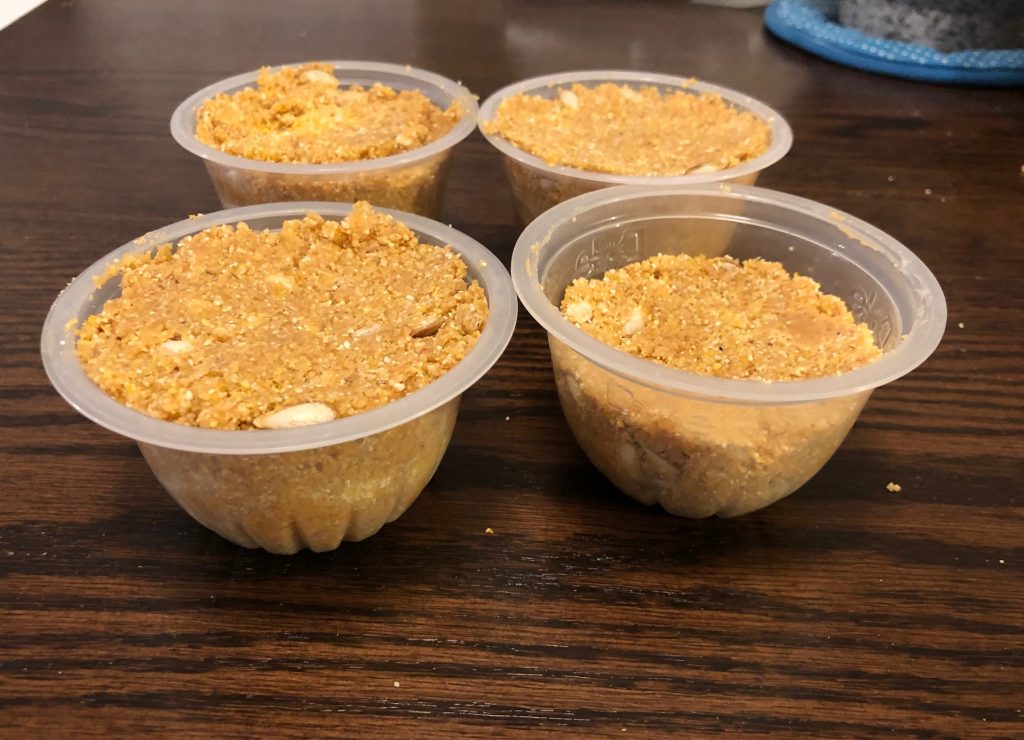
I’ve been adding these to the regular food at the feeder at the rate of one or two a week since Thanksgiving. These treat cups seem to be second in popularity only to the the meal worm blocks. I suppose that’s due to the protein and fat content for the winter. It’s fun to watch the backyard residents pecking away at something I made myself.
I decided that I’m going to grow sunflowers this year to help save on birdseed as well. According to the internet, saving and drying sunflower seeds – either for human or bird consumption – isn’t difficult, so I’m going to give that a whirl too.
So bottom line – seeds are an investment in our nutritional future. If you’re planning a garden this year you’d better get on the stick and get your order in. Unless you are already ahead of me and are an heirloom seed saver from way back. But even if you’re not, all is not lost. Look at the produce you already have and see what DNA-packed goodies may lie just beneath the surface of that vegetable – just waiting for some soil and sun and a little TLC.
The Ithaca 37 – An American Icon
When I get to do nerd stuff with shotguns, I get giddy. Really giddy, and recently an original 1950s Ithaca 37 fell into my lap. I’m cleaning it up for a friend, and in doing so, I get to shoot and test it, of course. The Ithaca 37 is a historical shotgun that’s served generations of hunters, law enforcement, and military forces. It’s carved its way into the shotgun hall of fame, and today we will discuss why.
Specs and Details and History
The Ithaca 37 is a John Browning design, and very few people credit Browning with the design. I feel this is often ignored because Browning didn’t work for Ithaca. He worked for Remington when he designed the Remington Model 17. The Model 17 was a lightweight 20 gauge shotgun, and the Model 17 patent eventually expired. This allowed Ithaca to beef up the design to 12 gauge and release their very own shotgun. That being said, Ithaca made a few changes to make the design more affordable to produce.

The Ithaca 37 hit the market in 1937 and didn’t do great. The world was on the verge of a World War once more, the great depression was raging on, and honestly, it seemed like the worst possible time to release a sporting shotgun. Ithaca could have been left holding an expensive bag, but the wartime need for handguns and long guns gave Ithaca an infusion of much-needed capital. The Model 37 was even adopted for limited use in the war with the changes necessary to make it a trench gun.
Post-WW2 Ithaca 37
The war ended, and Ithaca began producing the sporting variants of the Ithaca 37 once more. The gun started life as a hunting shotgun and was a popular choice, quickly becoming a favorite of duck hunters. Enough so that Ithaca did some fancy inscribing work and left some of the higher grade models adorned with ducks flying.
The Ithaca 37 quickly became the American standard in modern magazine fed shotguns. It packed a variety of modern features into a very simple and reliable pump-action shotgun.
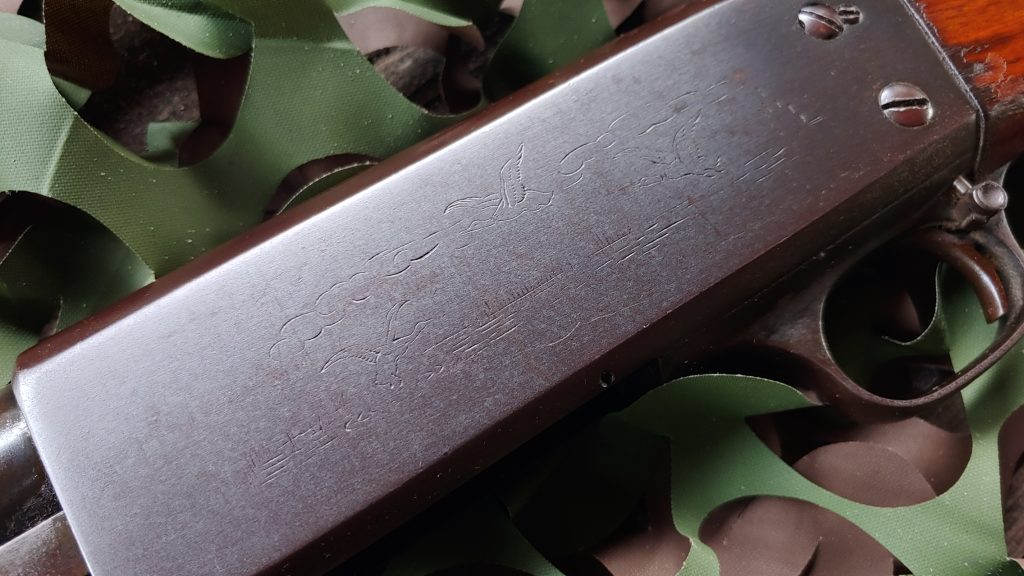
Like most shotguns, the Ithaca 37 saw more widespread use in the tactical world as well. It was adopted by the military outside of just WW2. It served in Korea, as well as Vietnam. In Vietnam, it gained an excellent reputation for durability and reliability with special operations forces. It shrugged off the austere environment that is the jungle. It was also a popular choice for police forces, not to mention that Detective Ricardo Tubbs used a Stakeout model in Miami Vice.
The Ithaca 37 Featherlight
Ithaca graced the 37 with the title featherlight, which seemed like an odd title for a 7.5-pound shotgun. To be fair, other slide-action shotguns like the Model 1897 weighed 8 pounds, so the Ithaca was lighter than most. This model is outfitted with classic American walnut furniture. This includes the corn cob forend and wooden stock outfitted with a plastic butt plate. No rubber limb saver pad here.
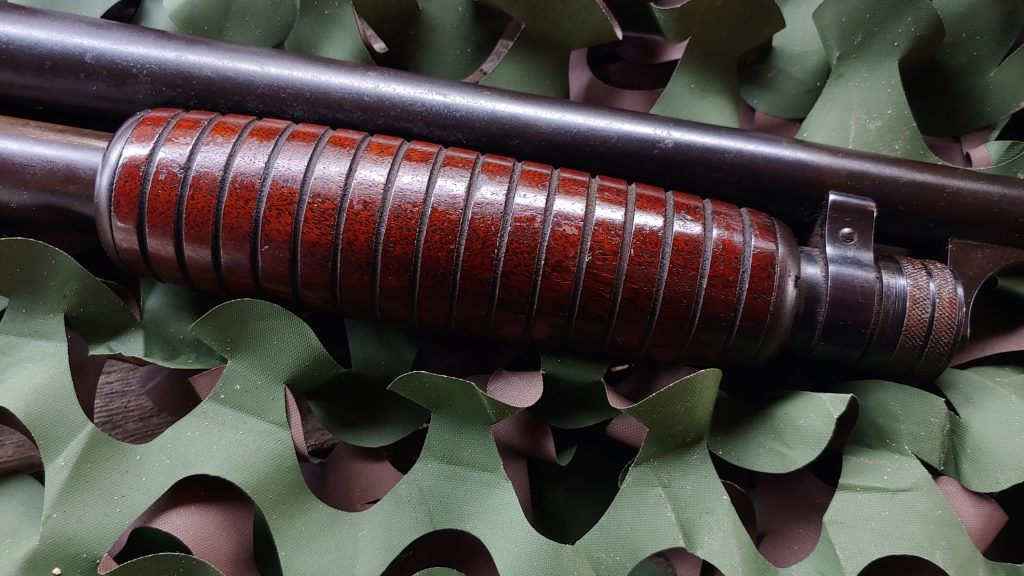
The length of pull is 13.5 inches, which is a little long for some smaller shooters, but much better than the modern obsession with 14.5-inch LOPs. It is extremely comfortable and shoulders naturally. The weight is locked to the rear, and the barrel is somewhat thin. This is good for a natural swing and something I’d imagine most bird hunters desire. The Ithaca 37 is also easy to hold in the firing position for a long period of time.
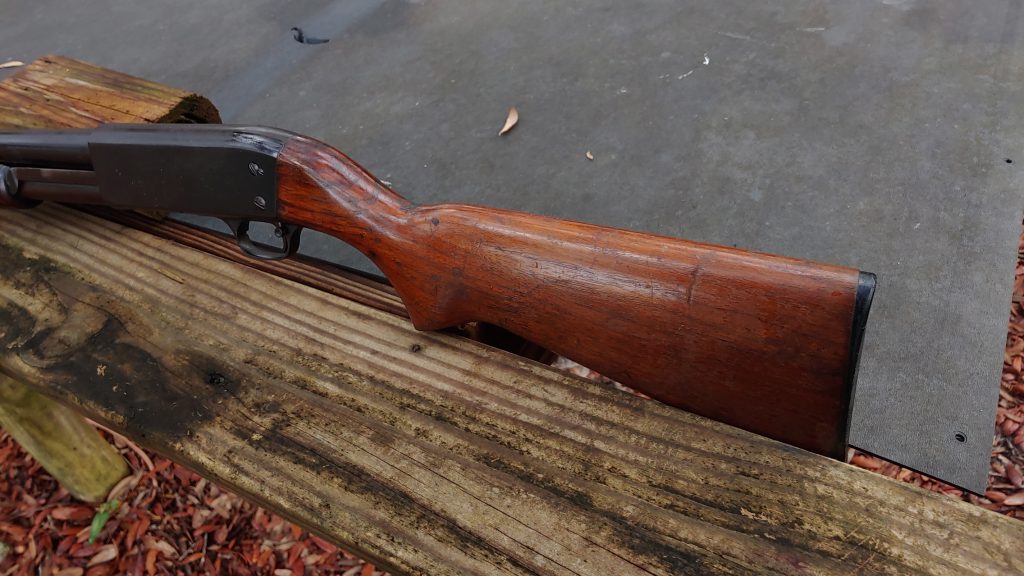
The controls are well done with easy access safety and pump release. The safety is better suited for right-handers, but the pump lock is easy to reach with either hand.
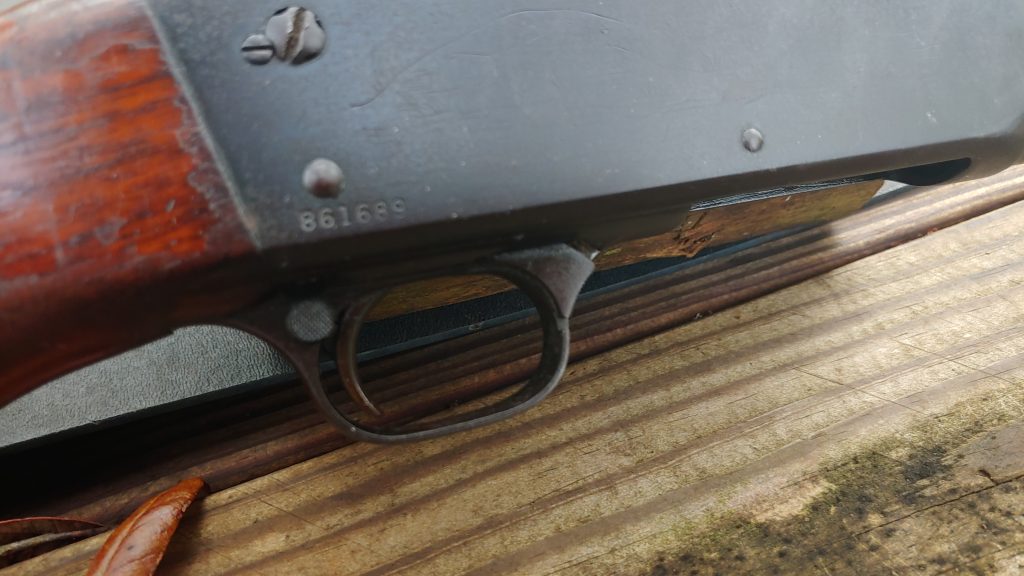
Overall, it’s a well balanced little gun, and I can see why it’s the longest produced pump-action shotgun on the market. Even with the modernized variants of the Remington 870 and Mossberg 500 series, the Ithaca 37 remains in production.
What Separates the Ithaca 37 from the Pack
The Ithaca 37 loads and ejects from the bottom of the gun. The original Model 17 did the same, as does the BPS. This bottom-loading design makes the shotgun highly desirable for a number of reasons. First, it’s perfectly ambidextrous. Lefties and righties can both use it to great effect.
The Ithaca 37 became particularly popular with duck hunters due to this bottom ejecting design. In a crowded duck blind, the shells eject downwards instead of into your friend’s faces. The bottom ejection also keeps the shells in a boat and not dumped into your local pond.
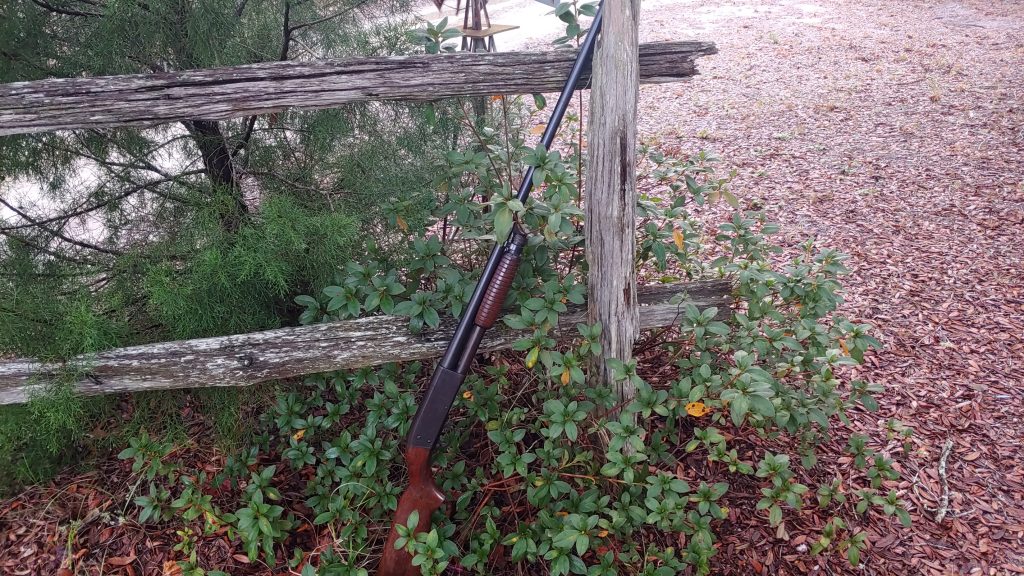
The bottom ejection design also means there is only a single slot in your gun. This makes the gun a tank capable of resisting dirt, grime, mud, and snow like an M4 Sherman throws off German infantry. This is valuable in duck season when it’s wet and muddy and in the Vietnam jungle, where this shotgun earned its reputation for reliability.
The closed receiver lets nothing in and doesn’t allow the gun to be filled with anything but shells and hate.

Another feature in Ithaca 37’s produced prior to 1975 is the lack of a disconnector. This means if you hold the trigger and pump the gun, it will fire as soon as the pump closes. This makes dispensing those shells and that hate very quick. This 1950s built Ithaca 37 lacks the disconnector, and I will say it’s a very effective technique that makes it easy to empty a magazine tube in mere seconds.
The recoil is fierce, admittedly, and from the hip, it’s a bit more fun and easier to control than doing so when shouldered.
The Ithaca 37 Downsides
If you look around today, you’ll see plenty of Ithaca shotguns still in use. They are a favorite for hunters to this day, but they’d faded away from the tactical scene. One of the big reasons is the single action bar. Modern pump shotguns use a dual-action bar for increased reliability under stress and smoother pump action. Dual-action bars are hard to jam up, where single bars can twist and bind, making pumping difficult.
The lack of a standard ejection port also makes port reloads and slug select drills somewhat difficult.

The forged receiver is also an expensive proposition, and that’s why your modern produced Ithaca 37’s cost right around a grand.
The Ithaca 37 is an all American shotgun. It represents American design and innovation alongside a certain degree of craftsmanship we often see today. The Ithaca 37 is a workhorse and has proven itself over and over. Shotguns like my example are still fully functional weapons that don’t require a soft hand or a kind touch. If you’re lucky enough to have a classic model, appreciate it, love it, and shoot it. Shoot the hell out of it.
True North Concepts GripStop: The First and Original Gripstop
Since knowing True North Concepts, LLC the company has shown that it cares about advanced design and products that can be used to truly improve the users ability to do their job. In this case, weapons handling.
The Company

Sitting down with the owner and founder of True North Concepts it was instantly known that his mind came from a place of engineering and problem solving. That is exactly what his company aims to do. “True North Concepts, LLC designs and develops solutions to problems that haven’t yet been solved. Across all industries and applications, True North exists to create the finest tools to prepare men and women for any challenge that comes their way.”–truenorth-usa
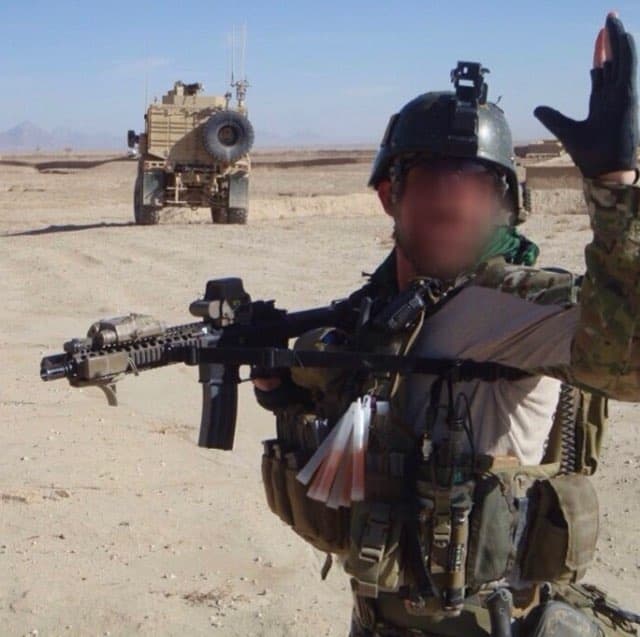
It was also plain to see where the true passion came from with his company, military folk who need truly thought out equipment. The True North Concepts GripStop was made for that need.
Understanding how we got here in the first place…
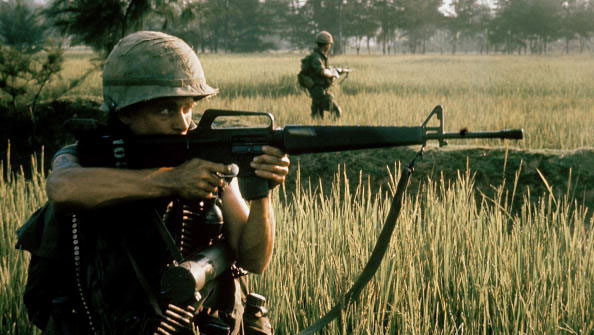
The Idea
Innovation, a term that is easily thrown around without proof of concept. Seven years ago the innovative GripStop began. It is the first and the only true GripStop.
It began with the same mindset that the owner has, how do we fix a problem, how do we truly make something that “pushes the envelope of design”, True North goes on to say. Weapons handling was that avenue of approach.
The C Clamp, gripping of the magwell, etc. These techniques go all the way back to the Vietnam War Era.
During these early conflicts we see infantrymen making their own accessories. Some using extra pistol grips and some making them straight from wood. 40 years from then and still no significantly innovating products despite a clear need.. until Mr. Reed Knight and the truly innovative Knights Armament Company’s design of the Rail Interface System (RIS). This development enabled operators to put the tape away and finally mount their lights and other accessories on a true mounting system, the picatinny rail. This developed standard pushed forward more accessories, including the Knights Armament Vertical Foregrip.
A lesser known fact, “Mr. Reed Knight believed in this product so strongly, that it was added to the supplied rail cover kit-roll for free, because of the lack of enthusiasm shown for it by the government, when looking at a contract for their rail forearm.” -True North Concepts
With the KAC Vertical Foregrip reinvigorating weapons handling accessories, we now see shooters start to modify their grips such as cutting them down into shorter stops.
#embrace the radius
With each of these modifications, True North Concepts saw one thing that stayed true, shooters wanting to “fill the dead space of a right angle” with their hand.
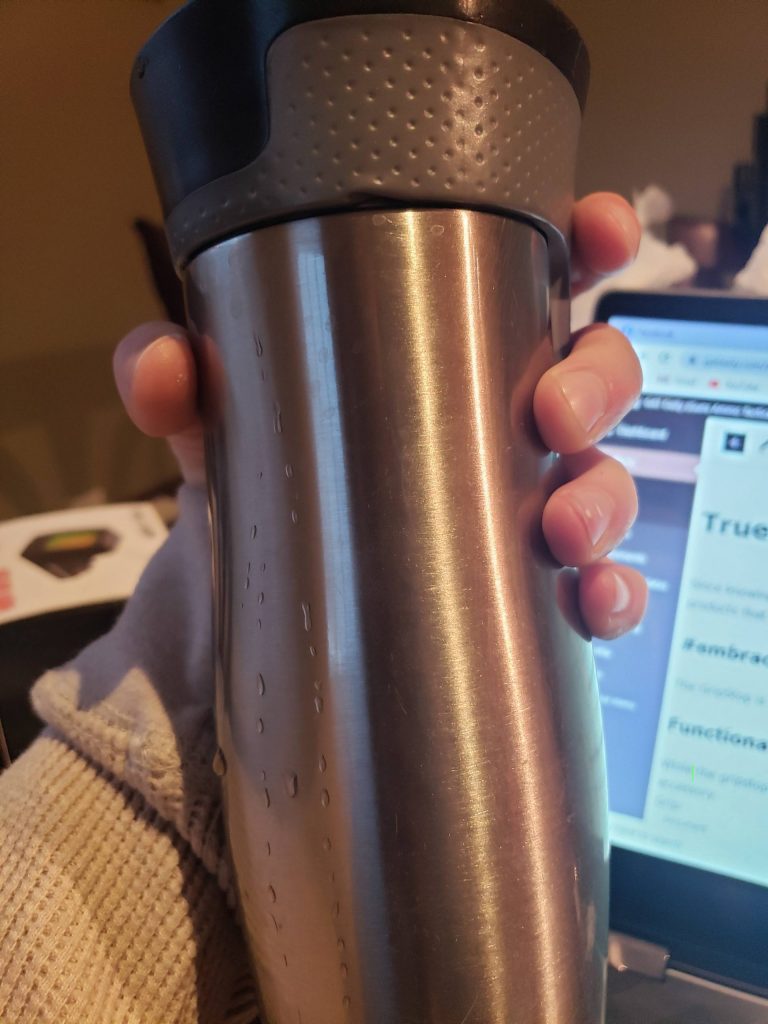
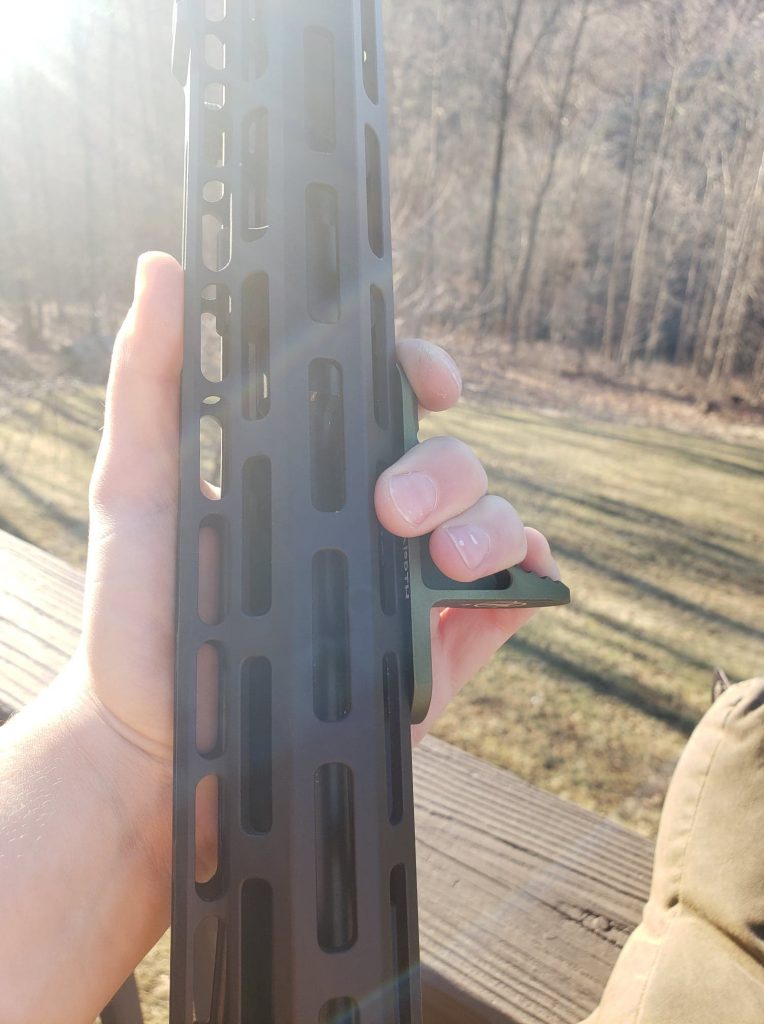
Research and Development
The best designs that we see are made from the ground up. The GripStop literally started out as putty. Placing a bracket with epoxy putty onto a rail and molding a hand around it as it would naturally grip a gun. Genius right? Don’t design the body around the equipment, design the equipment for the body.
In relation: Setting out a tripod for sitting position? Sit down first then adjust the tripod to your natural position. Don’t adjust your natural position to the tripod.
True North then took those molds and sent them out to multiple facets of Military folk to use and give feedback on. This doesn’t mean that the company sent them out to writers or influencers or people with a name.. He literally sent them out to gunfighters who were using their equipment to protect their lives each day. That takes a large sense of responsibility when designing a piece of equipment.
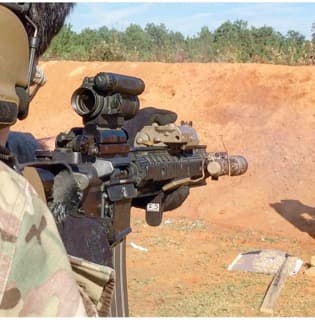
The GripStop that we have now was overseas in gunfights before it was agreed upon to be the last and final design.
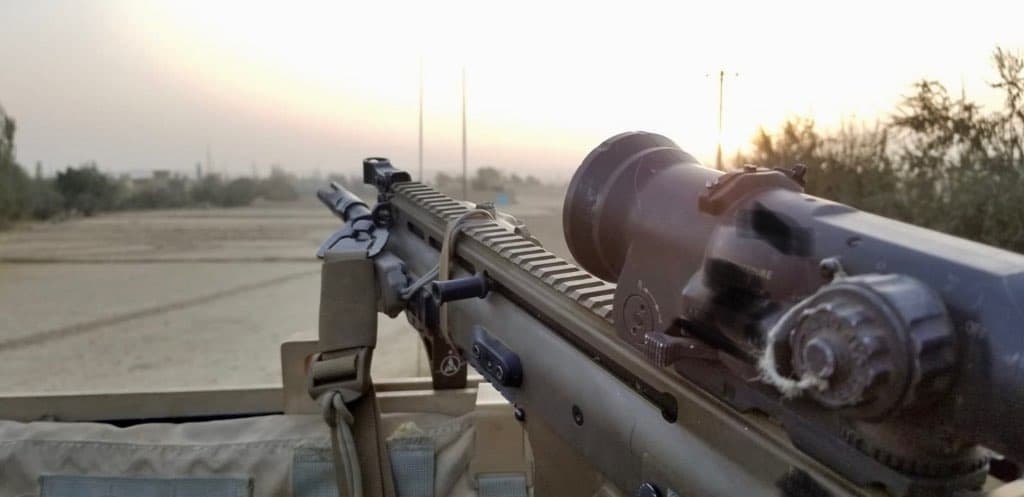
Functional vs Cosmetic Accessories
The GripStop is a truly functional accessory. When talking to True North he often brought up how versatile the product is. Users have the ability to run the radius forward, run it backwards, use it was a barricade stop on round railings. It is designed for the user, any user.
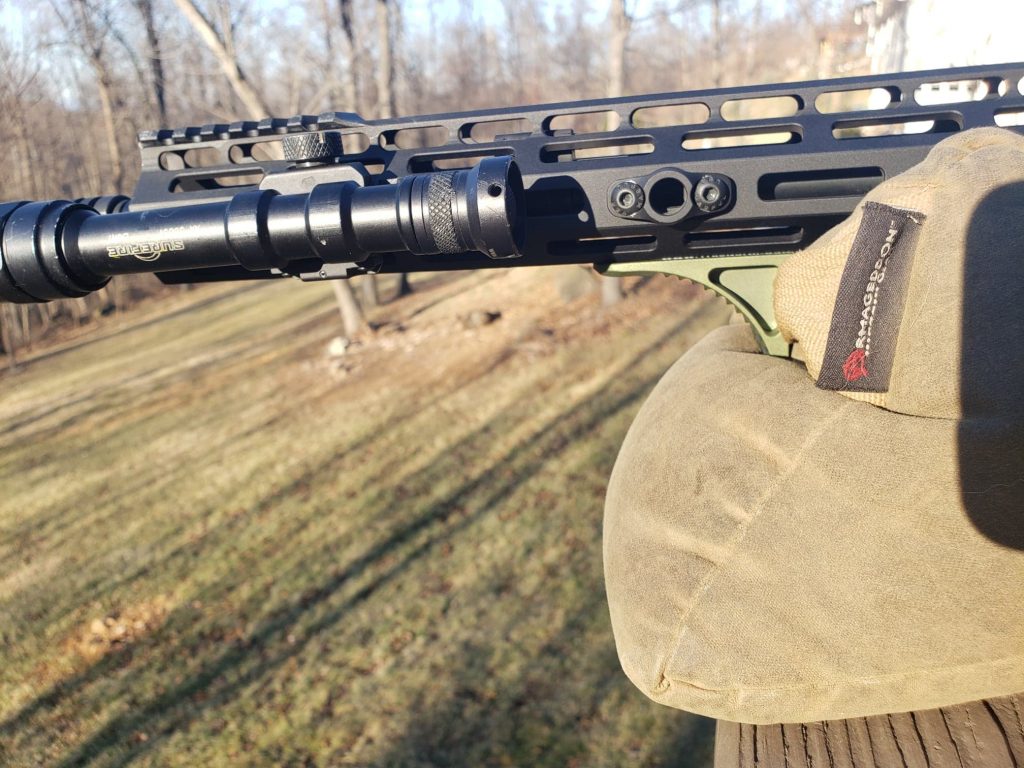
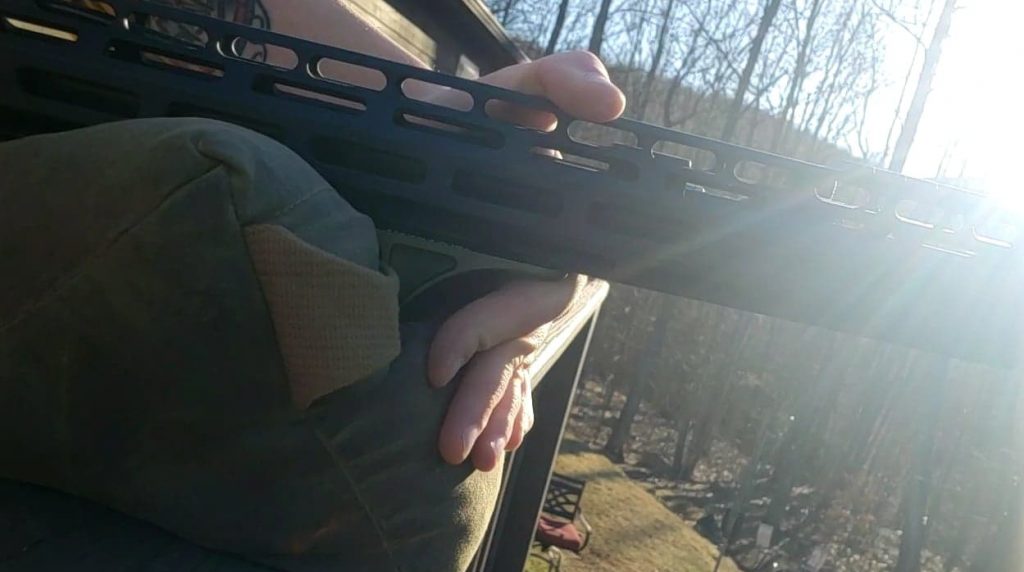
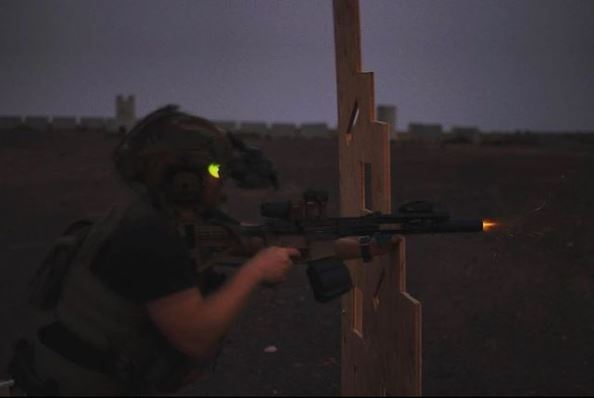
https://www.instagram.com/p/CFnpTcLJE_q/
The texture, like everything else, had tremendous thought placed into it as well. It features a type of versatile bite that won’t wreck your hands or police cruisers doors as your using them for support.
Mounting
The GripStop directly mounts to your M-Lok or Picatinny Rail using two allen head screws. Previous grips within the firearms world had to be attached with another picatinny section. This means that you would have another piece of hardware plus your grip both being forced back on. Parts can come loose.
When mounting to a rail that you don’t want to uninstall, install the M-Lok plate onto the screw before so it will grip the space inside the rail. Push through the rail. Once the plates are through the rail turn, the screw just enough (90 degrees, 1/4 turn usually) to get the plate to grab onto the rail where you’d like, it then pull up (away from the rail). This will allow the plate to put pressure onto the railing and give you the ability to tighten down the screw.
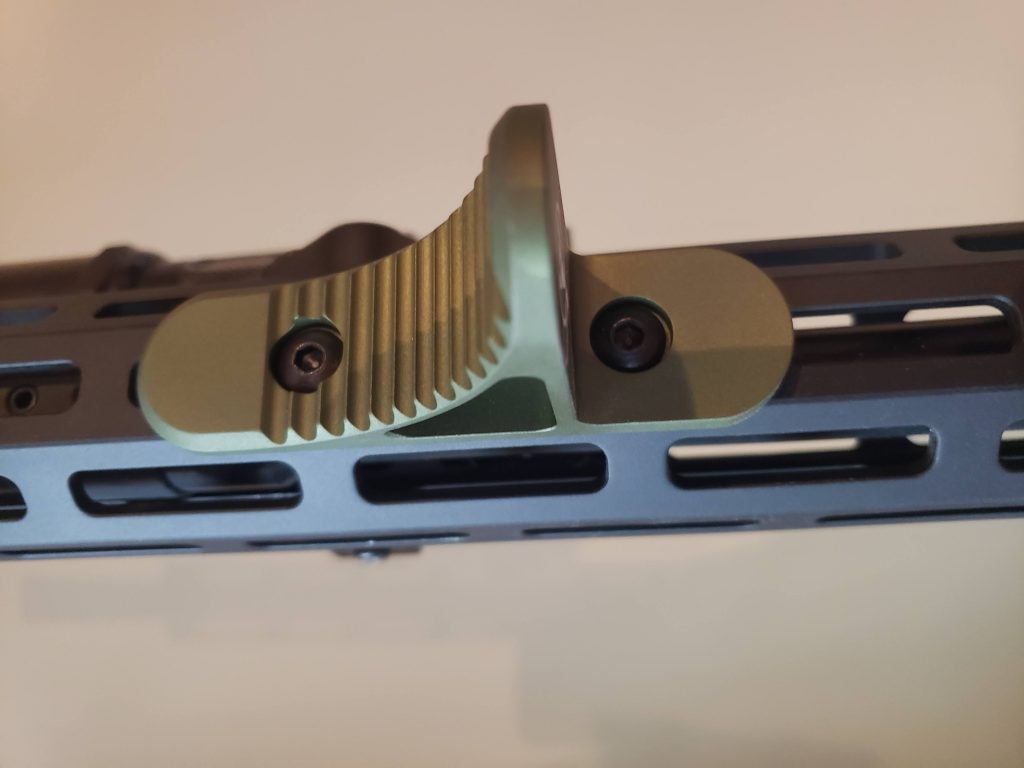
Specs and Options
The GripStop comes in two size options and three color options.
Everything is made with strong 6061 Aluminum Construction and uses Milspec Type III anodizing. These products are made right next to other anodized military products.
Which also means…IT’S MADE IN THE USA.
They are light in weight. Both K and Standard models weighing 2 oz with hardware and the Picatinny version weighing 1.7 oz.
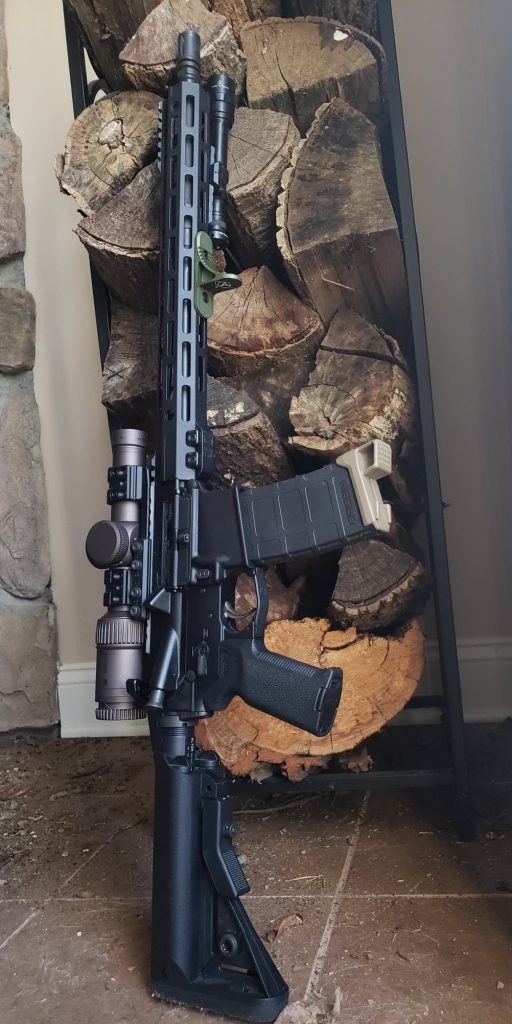
Other Products
True North Concepts also makes a Modular Holster Adapter that changes the game on mounting the different kinds of holsters and hardware that are being run.
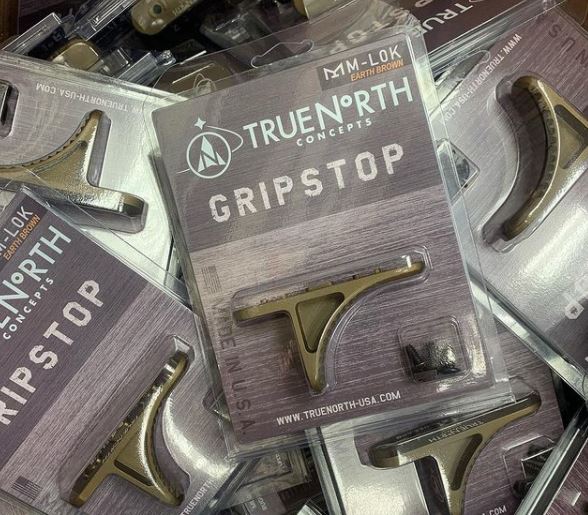
They say that those who don’t learn from history are doomed to repeat it. True North Concepts used every failure point and every move towards success as a true teaching moment. They learned and designed a product that we can fit to our body and technique. A truly innovative product.
Sig Sauer Releases the M18-Commemorative
The limited release of the M18-Commemorative Edition of the official U.S. military service pistol, a variant of the SIG SAUER P320, is now available. The M18-Commemorative pistol shares the same components, coatings, and markings as the firearm that was awarded the U.S. Army contract for the modular handgun system (MHS), and was recently chosen as the official sidearm of the U.S. Marine Corps.
To complement the M18-Commemorative, an exclusive M18 Collector’s Case is available and features a slate-grey flocked foam insert and precision laser placement cuts for the pistol, the official serialized M18-Commemorative Certificate of Authenticity, and the serialized M18-Commemorative Challenge Coin.

While the M17 was selected by the US Army as their sidearm of choice, the M17 and M18 were developed in tandem with the rest of the P320 line and the M18 won selection in the remainder of the services.
The principle difference between the two is slide and barrel length. The M18 uses a shorter slide and barrel while still set to accept the HRS optic and IR capable laser/light that are also part of the Modular Handgun System competition. Units can up kit or down kit their guns as need dictates.
The commemorative guns come in handsome clean wooden cased and are fine pieces to add to the collection. They are limited in their runs so using one as an EDC, while entirely your choice, not what the intention is with this particular production unit.
The M18 uses the Carry/XCarry layout which retains its 17/21 round capacity while shortening the slide and barrel to the compact model length. This, in the conjunction with AXG grip makes for an absolutely phenomenal shooting package.
Does the FAL hold up?
The FN FAL, ‘Right Arm of the Free World’ (because most people are right handed, I assume) How does it hold up today?
Mike ‘GarandThumb’ is back with another review video on the DSA FAL. The FN FAL is one of the three legendary .308’s of the Cold War Era and probably holds the most distinguished career. The Germans, as you may know, started with the FAL as the G1 rifle but went to the enhanced CETME design that became the G3 thereafter, playing off of their perfecting the roller delay systems that H&K would become known for, through sheer stubbornness mostly.
The FAL was even submitted here in the US as the T48 but was ultimately rejected for the third in the trio, the M14, for a mix of good reasons, made up reasons, and the Army’s institutional love of .30 Cal and the M1 Garand.
It isn’t that the M14 didn’t run, it did. It is that the M14 was functionally obsolescent when it was chosen. Better designs existed, but the US chose to invest heavily in a surpassed technology. Now look at us, reviving the ~6.8mm Battle Rifle with the NGSW, on an evolved variant of those designs.
But such is the path we walked, we have made some very nice .308 battle rifles because it was the chosen caliber. Then the 6.5 Creedmoor finally broke down the blockade into the ballistic efficient (widely accepted) chamberings for 100-150 grain projectiles. Humans can be slow and stubborn creatures. I didn’t want to abandon my trusty ACOG for a “fragile” LPVO or put a red dot on a pistol, and those turned out to be silly notions to cling upon.
But, as you enjoy Mike’s, and Ian and Larry’s, videos let us discuss the state of the FAL.
Obviously the rifle is still in new production with DSA. They make several variants and have successfully adapted many modern features to the platform including folding/adjustable stocks and negative space rail systems. The rifles start at about $1,500 retail for a basic 21″ barreled Bolivian FN Pattern gun to the $2,300 range for a fully-featured variant.
So, it is a legacy platform with a good reputation that has modernized options to keep it viable. Sounds like something else I was just talking about.
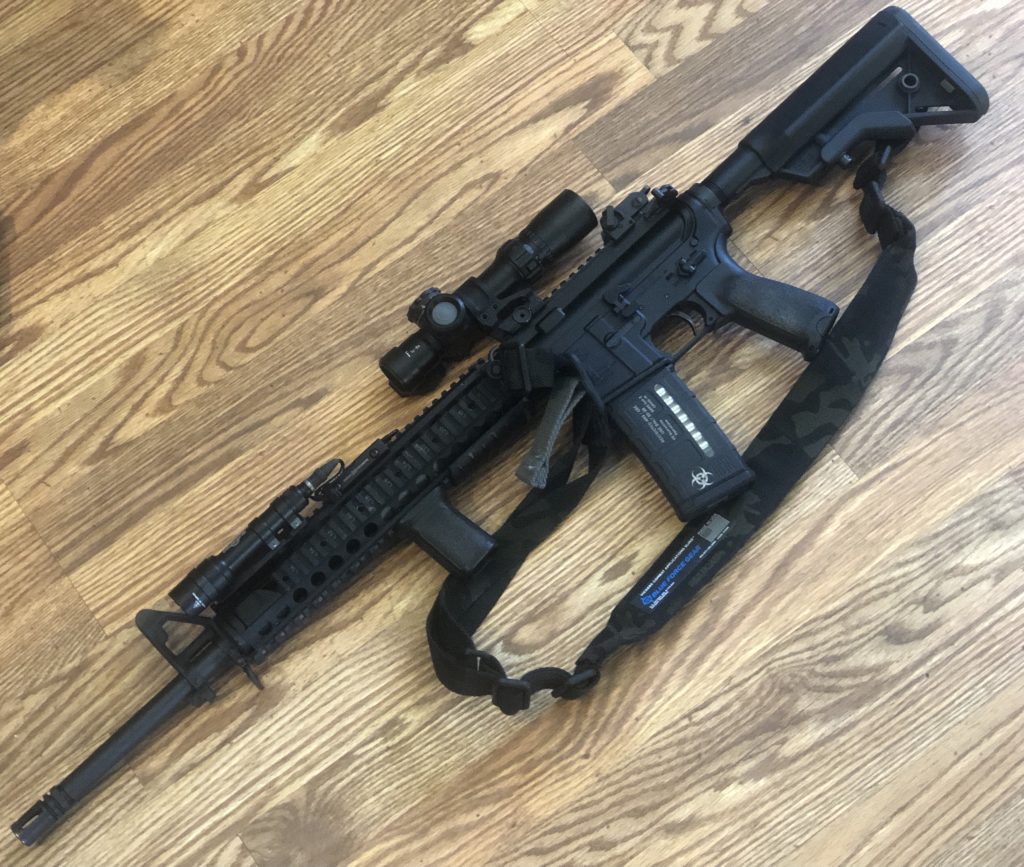
Yes, the FAL stands up. Willingly accepting the limitations of the 7.62/.308 because it still holds major strengths (like production capacity and international acceptance) the FAL is a highly viable platform and will remain so for decades to come. The limitations of .308 aren’t really all that limiting if it is the can of ammo you have.
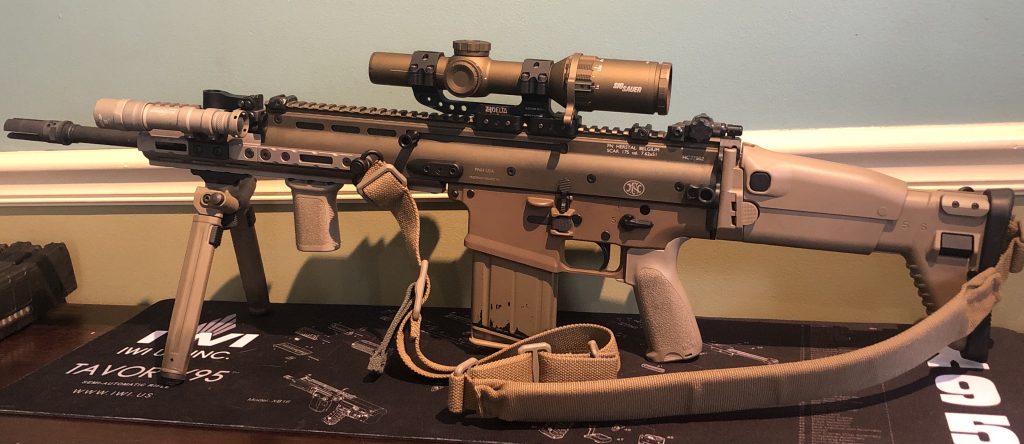
What the 21st Century of firearms development is showing us is that the major leaps were made in the 20th. The 21st is about refinement of the lessons learned in the 20th and beyond. Each iteration of the M16, DMR, Battle Rifle, etc., is still essentially these same rifles with a few more lessons learned smoothed into the designs, and some of those lessons we knew all the way back in WWII’s timeframe.
The era of the box magazine fed rifle.
So no, don’t rush to trade out your cold-war “relics” for NGSW inspired new hotness. Sure, buy the new hotness as it comes. Run and experience the improvements. But just as a new computer graphics processor doesn’t make an older one stop working, newer better firearm tech does not make legacy systems lose effectiveness. They are as efficient and reliable as they were made, developed, and improved. They simply exist within their design, both its strengths and limits, while new designs can learn from those legacies.
As we navigate this time of strife upon the world stage, many have discovered (or rediscoverd) the importance of personal armament. This comes with entering a world full of information, and just a full of conjecture.
Fudd-lore is alive and strong, the thing that you heard from the one buddy one time, or it ‘always worked for so-in-so,’ or you have a sibling who was in the military, or any number of other quick pieces of (probably) goodwill intended wisdom that lacks the context to make it of real value so its probably more harmful than good… exists in oil tanker sized caches upon the tides of the internet.
But a mature gun design with a well earned reputation is worth the investment in a way that a new radical wizz-banger AR thing from a company you’ve never heard of but, “Man its only $800, during a pandemic! And they’re all made in the place anyway.” just won’t match. Ever.

